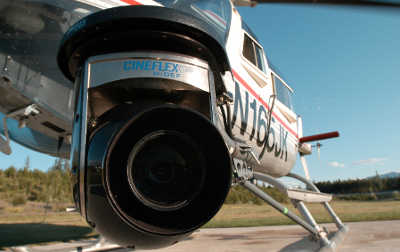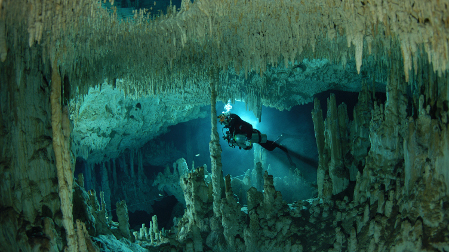Making a Highly Defined 'Planet Earth'

"Planet Earth" producers used the Cineflex Heligimbal, which was usually equipped with a Sony 750 HDCAM and Canon 400 mm zoom lens to capture images from hundreds of meters away.BETHESDA, MD.
"Planet Earth," a new 11-hour HD series from the BBC, will air on five consecutive Sunday evenings on Discovery HD and Discovery Channel, beginning March 25. The ambitious project deployed 70 producers and camera operators to more than 200 locations globally over a five-year period with the assignment to capture living natural history in HD detail.
The result prior to post production was several hundred hours of tape depicting scenes in the wild rarely ever seen by humans--thanks to the ability to shoot from unobtrusive aerial vantage points through high-powered lenses, courtesy of the Cineflex heligimbal.
UNDERCOVER
The gimbal from Cineflex LLC, based in Grass Valley, Calif., is a gyro-stabilized aerial unit that, for this BBC production, was equipped with a 400 mm Canon zoom lens that was able to closely track wildlife in natural habitats from hundreds of meters away without being detected by the animals.
"It was truly amazing to be able to suddenly film certain things from the HD aerial gimbal in a matter of days or weeks that would have taken perhaps years to film," said Huw Cordey, a veteran BBC producer who was responsible for three episodes in the series ("Caves," "Deserts," and "Jungles"). "Some of these sequences would never have been captured had we not been [shooting] from so far away and had our presence been known by the wildlife."
Cordey used 14 camera operators for shoots in the Gobi Desert of Mongolia and the Australian outback, among other locales. The "Caves" episode, the final installment airing April 22, took Cordey's team to the Lechuguilla Cave in New Mexico, the deepest known cavern in the continental United States.
"We shot a lot of footage on the Sony HDW-750, especially where we were controlling the light, such as in the cave," he said.
A Sony HDC-950 was used for much of the aerial gimbal shooting, along with a Canon HJ40 400x lens. The Panasonic Varicam, which Cordey sometimes used to give some sequences a film look, also got a workout at other sites.
The entire series--spanning nearly 2,000 shoot days--was captured in 720p, 1080i and 1080p--as well as a few sequences on HD-friendly 35mm film. Discovery HD will air the series in 1080i. Dolby 5.1 Surround Sound also will be featured, although much of the audio was laid in later (along with narration by actress Sigourney Weaver)--especially footage obtained from the heligimbal, which was too far away from its prey to record pertinent audio (which, in turn, would have been drowned out by aircraft engines).

A BBC camera operator files in the flooded caves of the Yucatan in MexicoFILM AND VIDEO
Cordey said he found the technical jump from film to HD tape far simpler than he would have imagined.
"It was actually surprisingly easy," he said. "I'm a film man working in natural history. Film cameras typically are very reliable. Working in natural history is operating in an aesthetic medium, and film creates that cinematic look we sometimes go for. We found for the first time that a video camera such as the Panasonic Varicam and [Sony's] could compete with film cameras on frame rate, reliability and other big issues."
Some of the camera work's vantages points were unique, he said.
"Being able to film something is one thing, but you're looking at something sometimes familiar, sometimes very unfamiliar, from a totally different perspective" via the aerial gimbal, he said. "We have this wonderful opportunity to see exotic animals actually interacting within the context of their own environment."
When preproduction began more than five years ago and it was decided to shoot in HD, the commercial prospects for high definition (especially in Europe) were still very much up in the air, rather than on it. (When the BCC aired the new series last month in the United Kingdom, it was in SD, not HD.) And in North America HD was still in it infant stages.
"Five years ago, deciding to go HD really speaks of [Discovery Founder and Chairman] John Hendricks' vision," said Maureen Lemire, series executive producer for Discovery Channel. "A few years ago, high definition was still a new format for most camera operators, and back then there had been rumors that were not good about dealing with HD."
Lemire, a former freelance producer, said the BBC knew without some recent technical advances, several of the series' sequences would not have been feasible.
"Capturing the Blue Bird of Paradise in low light never would have been possible without HD," she said. "Some people may have become a bit jaded with HD over the years, but viewing a lot of these scenes will cure that."
She said the bird's mating ritual is the first ever captured by electronic media of any kind.
One of the relatively few technical problems encountered by the Cordey crew on location was the extreme cold.
"We were on location in the Gobi Desert in Mongolia with virtually no roads or maps," Cordey said. "We used GPS navigation to get around. The temps were down around -30 [Fahrenheit] and we were staying in tents. We didn't know it when we started, but our best chance to capture HD images of a herd of wild camels came very early in the journey.
"We had this amazing opportunity on a stunning day--a blue sky, glistening snow, no wind," he continued. "We spotted the wild herd and we filmed all of it. When we got back to camp and looked at it through the black-and-white viewfinder, it looked great. But we soon discovered something had happened to the blue channel and everything looked yellow. The cold weather had knocked out the blue channel on the chip. We quickly learned to start up cameras well before actual filming to warm them up."
Lemire said every episode will be followed by a two-minute behind-the-scenes look at how some of the footage was captured. On April 24, two days after the Discovery channels air their final episodes, the series will be released on standard DVD. Soon thereafter, it will be released on HD DVD and Blu-ray Disc.
Get the TV Tech Newsletter
The professional video industry's #1 source for news, trends and product and tech information. Sign up below.
